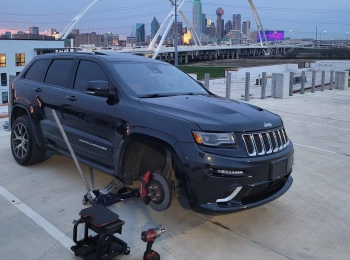Keeping your car’s electrical system running smoothly is key to reliable performance and safety. Whether you’re dealing with a dead battery or flickering headlights, the right diagnostic tools help you find problems fast and get back on the road. In this article, we’ll show you the top 10 car electrical diagnostic tools every DIYer needs, from simple test lights to advanced oscilloscope setups. Our favorite tool is the OBD-II code reader, which gives instant insight into your car’s computer and pinpoints issues with ease. With clear, step-by-step guidance, you’ll learn how to use each tool, save money on repairs, and avoid guessing games under the hood. Ready to take control of your car’s electrical health? Keep reading to discover practical tools and tips that make DIY car diagnostics simple and effective, leading to accurate repairs.
Table of Contents
- 1. OBD-II Code Reader
- 2. Digital Multimeter
- 3. Test Light (Circuit Tester)
- 4. Noid Light Set
- 5. Battery Load Tester
- 6. Alternator Tester / Regulator Test Tool
- 7. Insulation Resistance Tester (Megohmmeter)
- 8. Automotive Oscilloscope
- 9. Thermal Imaging Camera
- 10. Wiring Diagram App or Tablet Software
- Putting It All Together
- FAQs
1. OBD-II Code Reader
An OBD-II code reader plugs into your car’s diagnostic port usually located under the dash and reads trouble codes stored by the engine control unit. Instead of guessing what’s wrong, you get a clear code like P0302 (cylinder misfire), which points you toward the failing component.
- Why it matters: Eliminates guesswork and helps you decide whether you can fix the issue yourself or need professional help.
- Key features: Live data display, freeze-frame capture, code clearing.
- Pro tip: Look for models that offer bidirectional control, allowing you to run specific tests (like activating fuel pumps or fans) directly from the scanner.
2. Digital Multimeter
A digital multimeter (DMM) measures voltage, resistance, and current, making it invaluable for testing batteries, alternators, fuses, and wiring continuity. You can check whether a wire is delivering power or find a short circuit trace.
- Why it matters: Provides precise readings so you can spot drops in voltage or spikes in resistance that signal trouble.
- Key features: Auto-ranging, data hold, backlit display for working in dark engine bays.
- Pro tip: Invest in a model with a dedicated auto-range for voltage to avoid constantly switching settings.
3. Test Light (Circuit Tester)
A test light is a simple probe with a lightbulb or LED that lights up when current flows through it. Clip the ground lead to the battery negative, and touch the probe to fuses, switches, or connectors to quickly verify power presence.
- Why it matters: Fast, intuitive check for power at various points without the need for complex setups.
- Key features: Sharp probe tip for tight spaces, insulated handle, built-in resistor for protection.
- Pro tip: Use a fused test light to prevent damage if you accidentally probe a low-resistance circuit.
4. Noid Light Set
Noid lights are used to test fuel injector pulse. Each injector connector gets its own LED adapter; when the engine is cranked, the lights flash if the injector driver is working.
- Why it matters: Isolates injector driver failures from fuel delivery issues.
- Key features: Full set for 4- to 8-cylinder engines, durable leads, bright LEDs.
- Pro tip: Combine with a scan tool to verify injector timing and pulse width in real time.
5. Battery Load Tester
A battery load tester applies a controlled load to your car battery, simulating cranking conditions. It measures how well the battery holds voltage under stress and reveals weak cells that a simple voltage check might miss.
- Why it matters: Ensures your battery can deliver adequate cranking amps, preventing no-start situations.
- Key features: Adjustable load currents, built-in voltmeter, temperature compensation.
- Pro tip: Test batteries when fully charged for the most accurate health assessment.
6. Alternator Tester / Regulator Test Tool
This tool monitors alternator output voltage and current while the engine runs at different RPMs. It helps you determine if the alternator and voltage regulator are maintaining proper charge levels.
- Why it matters: Detects under- or over-charging before they damage your battery or electronics.
- Key features: Clamps for current measurement, voltage readout, temperature compensation.
- Pro tip: Compare readings at idle and at 2,000 RPM consistent voltage between 13.8 V and 14.4 V indicates a healthy charging system.
7. Insulation Resistance Tester (Megohmmeter)
A megohmmeter applies high voltage (typically 500 V) to measure insulation resistance in wiring harnesses, motors, and coils. Low insulation resistance signals short-to-ground or deteriorated wiring.
- Why it matters: Reveals hidden shorts and leakage paths that cause parasitic drains or erratic behavior.
- Key features: Multiple voltage ranges, insulation breakdown detection, clear analog/digital display.
- Pro tip: Always discharge capacitors and isolate circuits before testing to avoid damage or false readings.
8. Automotive Oscilloscope
An oscilloscope displays voltage waveforms over time, making it the ultimate tool for diagnosing complex sensor signals, ignition patterns, and CAN bus data. You can see exactly how voltage rises and falls in milliseconds.
- Why it matters: Uncovers intermittent faults and waveform distortions that standard tools can’t detect.
- Key features: Multi-channel inputs, adjustable time/div and volts/div, storage for waveform comparison.
- Pro tip: Use manufacturer-provided waveform libraries as a reference for healthy signal patterns.
9. Thermal Imaging Camera
A handheld thermal camera shows temperature differences across components ideal for spotting overheating circuits, bad connections, or failing resistors without direct contact.
- Why it matters: Quick visual scan of the engine bay or fuse box to pinpoint hot spots before they fail.
- Key features: High resolution, adjustable temperature range, video recording.
- Pro tip: Use in combination with a DMM to measure actual voltage drops at hot connections.
10. Wiring Diagram App or Tablet Software
Digital wiring diagrams and repair manuals on apps let you trace circuits, view connector pinouts, and follow color codes right at the work site no paper manuals to shuffle through.
- Why it matters: Saves time by providing instant, searchable diagrams for any make, model, and year.
- Key features: Offline access, bookmark favorite circuits, layer views (power, ground, sensor).
- Pro tip: Sync with your phone or tablet to share screenshots or notes with friends or online forums for advice.
Putting It All Together
Having these ten tools in your toolbox empowers you to tackle a wide range of electrical issues, from simple fuse checks to complex sensor waveform analysis. Start with a basic kit OBD-II reader, multimeter, and test light and add advanced gear like an oscilloscope and thermal imager as you grow your skills. By investing in quality tools and learning how to use them correctly, you’ll diagnose problems faster, avoid costly trips to the shop, and keep your car running at its best.
FAQs
How to use a multimeter for car battery?
Set to DC volts, probe battery posts. Healthy battery shows ~12.6 V. If below 12.4 V, it’s weak. Use this simple test tool to spot battery issues.
Test light vs multimeter: which one first?
A test light quickly checks if power is present at a fuse or wire. If power is confirmed, use a multimeter next to measure exact voltage or resistance.
Why use a noid light on fuel injectors?
Noid lights flash at injectors when engine cranks. If a light doesn’t show flash, injector driver may be bad—helps you find injector faults fast.
When should I use a battery load tester?
Use it when battery shows low cranking. The tester applies load and shows if voltage stays above ~9.6 V, letting you know if battery can start your car.
How know if alternator is bad using a tester?
Run engine at idle and rev to ~2000 rpm. A good alternator holds 13.8–14.4 V. Outside range? Might be a bad alternator or voltage regulator.
Why add thermal camera in car electrical checks?
It finds hot spots in wires, connectors or fuse boxes fast. Spots over 150 °F show bad wiring or connections before they burn out.
How can I view car wiring diagrams for my vehicle?
Use a wiring‑diagram app on your phone or tablet. Search by make‑model-year, view connector pinouts and trace circuits before you start testing.









Leave a Reply